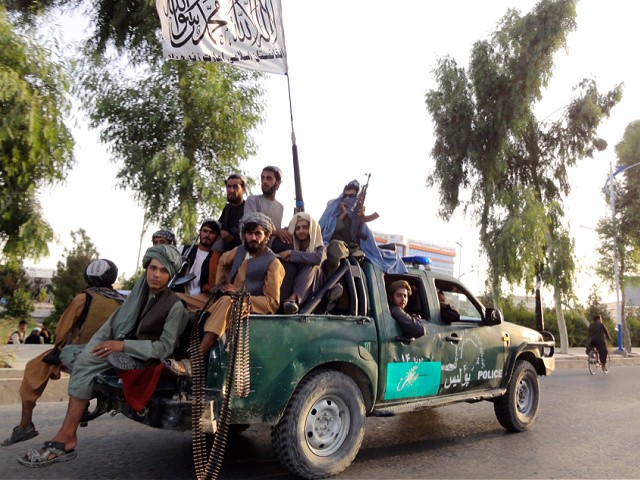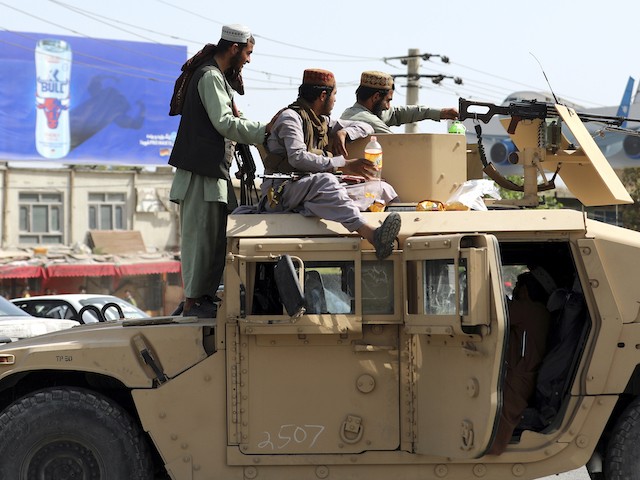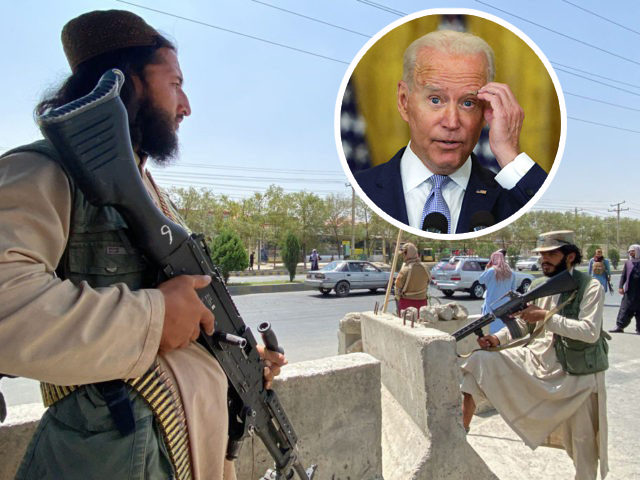The Taliban seized a staggering quantity of American military vehicles, equipment, and weapons when it overran Afghanistan in a week.
President Joe Biden, a Democrat obsessed with gun control, ended up giving billions of dollars of American weapons to the Islamist fanatics who helped perpetrate 9/11.
Only a month ago, Biden was bragging about the terrific quality of the modern “tools, training, and equipment” sent to the Afghan military at the expense of U.S. taxpayers over the past two decades.
Biden scoffed at the notion of an easy Taliban victory on July 8:
Together, with our NATO Allies and partners, we have trained and equipped over three hu- — nearly 300,000 current serving members of the military — of the Afghan National Security Force, and many beyond that who are no longer serving. Add to that, hundreds of thousands more Afghan National Defense and Security Forces trained over the last two decades.
We provided our Afghan partners with all the tools — let me emphasize: all the tools, training, and equipment of any modern military. We provided advanced weaponry. And we’re going to continue to provide funding and equipment. And we’ll ensure they have the capacity to maintain their air force.
“Do I trust the Taliban?” Biden said in response to a reporter’s question. “No. But I trust the capacity of the Afghan military, who is better trained, better equipped, and more competent in terms of conducting war.”
A little over a month later, the Taliban seized all of Afghanistan in a blitzkrieg that required only a little over a week to go from the insurgency’s first capture of a provincial capital to the fall of Kabul.
Along the way, the Islamist insurgency reportedly scooped up a vast treasure trove of American military hardware, capturing billions of dollars worth of armored vehicles, advanced drones, small arms, heavy weapons, and stockpiles of ammunition. They even captured American aircraft, which a CIA analyst assured AFP they would (probably) only parade around as trophies because they lack trained pilots.
That comforting assessment might not hold up for long, since there have been numerous accounts of high-ranking Afghan officials and military commanders making secret surrender deals with the Taliban. No evidence indicates it would be an insurmountable challenge for the Taliban to come up with some pilots if it wants them.
The accumulation of so much American hardware in Afghanistan over the past 20 years was driven by the persistent illusion that the government in Kabul commanded a stable and professional military who would employ U.S. skills and equipment to repel Taliban attacks on major cities.

Taliban fighters patrol inside the city of Kandahar, southwest Afghanistan, Sunday, August 15, 2021. (Sidiqullah Khan/AP Photo)
The Biden administration was stubbornly married to this illusion right up until the fall of Kabul. Even when major population centers and strategic cities began falling, often without a fight, Biden and his foreign policy team expected Afghan forces to rally, dig in around the most valuable targets, and beat the insurgents back with help from U.S. airpower.
Less than a week before Kabul was captured, the Biden administration predicted Afghan government forces could hold out for at least 90 days. A month before that, the administration expected Kabul to hold out for at least six months.
“We will continue to provide close air support. We’ll continue to resupply their forces with food and equipment, and pay all their salaries,” White House spokeswoman Jen Psaki pledged last Wednesday.
In response to a reporter’s inquiry, Psaki said it was a “good question” to ask if American close air support would last beyond August 31. As it turned out, Afghanistan did not last that long.
At the beginning of August, Afghan President Ashraf Ghani was claiming he had a six-month plan to roll back Taliban advances and force the militants to return to the negotiating table. We now know that Afghan regional officials were cutting secret surrender deals with the Taliban while Ghani was peddling that story.
This radical overestimation of the Afghan military’s fighting ability was a key reason why Biden allowed so many American weapons to fall into Taliban hands. Biden and his team were visibly stunned by the lightning speed of the Taliban’s campaign. So many of those conquests were carried out against such minimal resistance that most of the gear American taxpayers sent to the Afghan military was never used.
“Given how much we have invested in the Afghan army, it’s not ridiculous for analysts to believe that they’d be able to put up a fight for more than a few days,” grumbled Sen. Chris Murphy (D-CT) on Monday, attempting to defend the Democrat president and his team. “You want to believe that trillions of dollars and twenty years of investment adds up to something, even if it doesn’t add up for the ability to defend the country in the long run.”
As far back as June, Afghan forces were reportedly handing hundreds of U.S.-made military vehicles to the Taliban, including up-armored fighting vehicles with heavy weapons, usually without a scratch on them. Some of those armored cars were employed by the Taliban to slip past Afghan security perimeters and conduct suicide bombings.

Taliban fighters stand guard in front of the Hamid Karzai International Airport, in Kabul, Afghanistan, Monday, August 16, 2021. (Rahmat Gul/AP Photo)
If White House planners expected much of that American hardware to be destroyed in pitched battles with the Taliban, and many of those American bullets to be fired at the enemy, they must be severely disappointed with the real-world outcome. The insurgents were apparently able to conduct dozens, perhaps hundreds, of covert conversations with Afghan government and military officials without anyone in the U.S. intel community realizing a tidal wave of bloodless conquests leading all the way to Kabul was coming. If that was not the case, the intel community was aware of these conversations and failed to act in a manner that resulted in American foreign policy reflecting this reality.
There is growing chatter among disgruntled military intelligence officers that they did see what was coming, but the Biden White House ignored their warnings. The U.S. Special Inspector General for Afghanistan Reconstruction (SIGAR) has been warning for years that much of the American money sent to Afghanistan was wasted or stolen, which only helped the Taliban recruit public support against the corrupt U.S.-backed government.
At the end of July, SIGAR John Sopko accused U.S. military and diplomatic officials of knowing “how bad the Afghan military was” but concealing that knowledge to keep the twenty-year nation-building project rolling along.
“Every time we had a problem with the Afghan military, we changed the goalposts. The U.S. military changed the goalposts and made it easier to show success. And then, finally, when they couldn’t even do that, they classified the assessment tool,” Sopko said.
Sopko’s final report said much of the advanced combat and support equipment sent to Afghanistan was “beyond the capabilities of the largely illiterate and uneducated Afghan force.”
The Pentagon’s estimate of 300,000 battle-ready Afghan troops – quoted by President Biden in July, and supposedly dwarfing the Taliban’s 70,000 fighters – was also absurdly inflated, according to SIGAR. The Afghan Defense Ministry only claimed about half that number, and once support personnel and “ghost troops” fabricated by corrupt Afghan officials to steal payroll dollars were backed out, the actual number of frontline Afghan troops was 96,000 at best, with a desertion rate of nearly 25 percent even during the good times.
This meant the Afghan army did not have enough trained and reasonably committed soldiers to use all of the gear and weapons America provided. Much of the sophisticated gear the Afghan military did use was entirely dependent on American technical support and interoperations with U.S. military personnel. Biden also aggressively cut support from private contractors who might have been able to help the Afghan military use its high-tech equipment.
When U.S. forces pulled out under Biden’s orders, the Afghans simply could not use much of the equipment left to them. This was apparently very demoralizing for Afghan soldiers who might otherwise have been willing to fight the Taliban. Their morale was already poor, as their own government often neglected to pay or even feed them, even as top officials in Kabul saw to their own wealth and comfort. U.S. taxpayers shelled out $88 billion to buy weapons, while the Afghan government nickel-and-dimed the men who were supposed to use them in combat.

In this photograph taken on March 23, 2021, Afghan National Army commander Dost Nazar Andarabi keeps watch with binoculars at an outpost set up against Taliban fighters in Kajaki, northeast of Helmand Province. (Wakil Kohsar/AFP via Getty Images)
The Pentagon on Monday refused to answer questions about its plans to recover or destroy American weapons seized by the Taliban. Speaking off the record, a U.S. official confirmed to the Associated Press that the Taliban’s inventory of captured American equipment is “enormous.”
When the 20th anniversary of 9/11 arrives next month, it will find the Taliban controlling more of Afghanistan than it did in 2001. It now enjoys great power protection from China, which has developed large investments in Afghanistan’s minerals industry and would never allow a Western invasion to threaten those investments, no matter which murderous international terrorist gang the Taliban decides to harbor. And the Taliban is now armed with billions of dollars in high-tech American weapons.

COMMENTS
Please let us know if you're having issues with commenting.